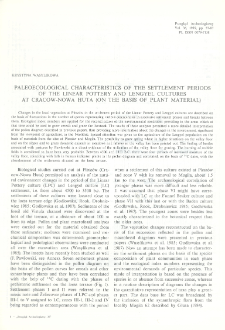
Object
Title: Paleoecological Characteristics of the Settlement Periods of the Linear Pottery and Lengyel Cultures at Cracow-Nowa Huta (on the Basis of Plant Material)
Subtitle:
Przegląd Archeologiczny T. 36 (1989)
Contributor:
Pawłowski, Jerzy ; Kuska, Antoni ; Stebnicka, Zdzisława
Publisher:
Polska Akademia Nauk. Instytut Historii Kultury Materialnej
Place of publishing:
Description:
ill. ; 29 cm ; Annex: Jerzy Pawłowski, Antoni Kuska, Zdzisława Stebnicka: The occurence of pasture species in the necrocenoses of beetles in the Neolithic profiles at Pleszów
Type of object:
Abstract:
Changes in the local vegetation at Pleszów in the settlement period of the Linear Pottery and Lengyel cultures are described on the basis of fluctuations in the number of species representing various communities in successive settlement phases and breaks between them. Ecological index numbers are applied for the reconstruction of the environmental conditions prevailing in the areas which at that time could be used to grow cereals and graze the livestock. The results of these analyses permitted a more detailed interpretation of the pollen diagram described in previous papers, thus providing more information about the changes in the environment, significant from the viewpoint of agriculture, in the Neolithic. Special attention was given to the agriculture of the Lengyel population on the basis of materials from the sites at Pleszów and Mogiła. The possibility to grow spring wheat in higher situations on the valley floor and on the slopes and to graze domestic animals in meadows and fallows in the valley has been pointed out. The finding of beetles associated with pastures by Pawłowski is a direct evidence of the utilization of the valley floor for grazing. The burning of stubble fields is considered to have been very probable. Between 4500 and 2800 B.C. there were four periods of increased moisture of the valley floor, coinciding with falls in human indicator plants in the pollen diagram and correlated, on the basis of 14C dates, with the abandonment of the settlements situated on the loess terrace
Relation:
Volume:
Start page:
End page:
Detailed Resource Type:
Format:
Resource Identifier:
oai:rcin.org.pl:60273 ; 0079-7138
Source:
IAiE PAN, call no. P III 149 ; IAiE PAN, call no. P III 272 ; IAiE PAN, call no. P III 353 ; click here to follow the link
Language:
Rights:
Rights Reserved - Restricted Access
Terms of use:
Digitizing institution:
Institute of Archaeology and Ethnology of the Polish Academy of Sciences
Original in:
Library of the Institute of Archaeology and Ethnology of the Polish Academy of Sciences
Projects co-financed by:
Ministry of Science and Higher Education ; Activities popularizing science (DUN)
Access:
Object collections:
- Institute of Archeology and Ethnology PAS > Institute Publications
- Institute of Archeology and Ethnology PAS > Institute Publications > Current Journals
- Institute of Archeology and Ethnology PAS > Institute Publications > Current Journals > Przegląd Archeologiczny
Last modified:
Feb 2, 2022
In our library since:
Nov 29, 2016
Number of object content downloads / hits:
24
All available object's versions:
https://www.rcin.org.pl/iae/publication/79621
Show description in RDF format:
Show description in RDFa format:
Show description in OAI-PMH format:
Objects Similar
Wasylikowa, Krystyna Starkel, Leszek Niedziałkowska, Ewa Skiba, Stefan Stworzewicz, Ewa
Kruk, Janusz
Kruk, Janusz
Podkowińska, Zofia
Godłowska, Marta Gluza, Irena
Borowik-Dąbrowska, Maria
Wasylikowa, Krystyna

 INSTYTUT ARCHEOLOGII I ETNOLOGII POLSKIEJ AKADEMII NAUK
INSTYTUT ARCHEOLOGII I ETNOLOGII POLSKIEJ AKADEMII NAUK
 INSTYTUT BADAŃ LITERACKICH POLSKIEJ AKADEMII NAUK
INSTYTUT BADAŃ LITERACKICH POLSKIEJ AKADEMII NAUK
 INSTYTUT BADAWCZY LEŚNICTWA
INSTYTUT BADAWCZY LEŚNICTWA
 INSTYTUT BIOLOGII DOŚWIADCZALNEJ IM. MARCELEGO NENCKIEGO POLSKIEJ AKADEMII NAUK
INSTYTUT BIOLOGII DOŚWIADCZALNEJ IM. MARCELEGO NENCKIEGO POLSKIEJ AKADEMII NAUK
 INSTYTUT BIOLOGII SSAKÓW POLSKIEJ AKADEMII NAUK
INSTYTUT BIOLOGII SSAKÓW POLSKIEJ AKADEMII NAUK
 INSTYTUT CHEMII FIZYCZNEJ PAN
INSTYTUT CHEMII FIZYCZNEJ PAN
 INSTYTUT CHEMII ORGANICZNEJ PAN
INSTYTUT CHEMII ORGANICZNEJ PAN
 INSTYTUT FILOZOFII I SOCJOLOGII PAN
INSTYTUT FILOZOFII I SOCJOLOGII PAN
 INSTYTUT GEOGRAFII I PRZESTRZENNEGO ZAGOSPODAROWANIA PAN
INSTYTUT GEOGRAFII I PRZESTRZENNEGO ZAGOSPODAROWANIA PAN
 INSTYTUT HISTORII im. TADEUSZA MANTEUFFLA POLSKIEJ AKADEMII NAUK
INSTYTUT HISTORII im. TADEUSZA MANTEUFFLA POLSKIEJ AKADEMII NAUK
 INSTYTUT JĘZYKA POLSKIEGO POLSKIEJ AKADEMII NAUK
INSTYTUT JĘZYKA POLSKIEGO POLSKIEJ AKADEMII NAUK
 INSTYTUT MATEMATYCZNY PAN
INSTYTUT MATEMATYCZNY PAN
 INSTYTUT MEDYCYNY DOŚWIADCZALNEJ I KLINICZNEJ IM.MIROSŁAWA MOSSAKOWSKIEGO POLSKIEJ AKADEMII NAUK
INSTYTUT MEDYCYNY DOŚWIADCZALNEJ I KLINICZNEJ IM.MIROSŁAWA MOSSAKOWSKIEGO POLSKIEJ AKADEMII NAUK
 INSTYTUT PODSTAWOWYCH PROBLEMÓW TECHNIKI PAN
INSTYTUT PODSTAWOWYCH PROBLEMÓW TECHNIKI PAN
 INSTYTUT SLAWISTYKI PAN
INSTYTUT SLAWISTYKI PAN
 SIEĆ BADAWCZA ŁUKASIEWICZ - INSTYTUT TECHNOLOGII MATERIAŁÓW ELEKTRONICZNYCH
SIEĆ BADAWCZA ŁUKASIEWICZ - INSTYTUT TECHNOLOGII MATERIAŁÓW ELEKTRONICZNYCH
 MUZEUM I INSTYTUT ZOOLOGII POLSKIEJ AKADEMII NAUK
MUZEUM I INSTYTUT ZOOLOGII POLSKIEJ AKADEMII NAUK
 INSTYTUT BADAŃ SYSTEMOWYCH PAN
INSTYTUT BADAŃ SYSTEMOWYCH PAN
 INSTYTUT BOTANIKI IM. WŁADYSŁAWA SZAFERA POLSKIEJ AKADEMII NAUK
INSTYTUT BOTANIKI IM. WŁADYSŁAWA SZAFERA POLSKIEJ AKADEMII NAUK
































